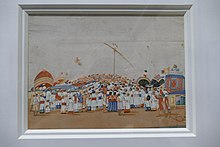Charak Puja
| Charak Puja | |
|---|---|
 Charak Puja being performed at village Narna, Howrah, April 2014. | |
| Also called | Nil Puja, Hajrha Puja |
| Observed by | Hindus |
| Type | Hindu |
| Related to | Gajan |
Charak Puja or Pachamara Mela (also known as Chadak, Nil Puja or Hajrha Puja)[1] is part of the Hindu folk festival of Gajan, held in honor of the deity Shiva or Dharmathakur.[2] The Gajan festival includes numerous forms of austerities like walking on hot coals or piercing the body with metal rods;[3] Charak refers to the practice of hook-swinging which generally is the last penance performed during the festival.
Gajan and Charak Puja is primarily practiced in the Indian state of West Bengal and in Bangladesh, but hook-swinging is traditionally practiced in other parts of India as well.[4]
The preparation usually starts a month in advance. The people responsible for the arrangement of the festival go from village to village to procure the necessary components like paddy, oil, sugar, salt, honey, money and other items needed for the ritual. At midnight of Songkranti, the worshippers gather to worship Shiva and Ma Durga for success. Afterwards a puja, the prasad (Items blessed by the deity) are distributed.[5]


Rarely, it’s also known as "Hajrha Puja". Women fast before this festival and male devotees swing from a pole with hooks being attached to the pole with ropes thrust through their backs.[6]
Charak Puja in Bangladesh
In Bangladesh, it frequently takes place in Moulvibazar, Thakurgaon district, and Galachipa Upazila of the Patuakhali District. Goalkhali, Gabua, Haridebpur, Lalua, Lohalia, and other villages are well known for "Charak Puja".[7] Though the aristocracy and frequency of the festival is being deemed now, it is still being performed regularly by people with an uncommon amount of devotion. For them it’s a part of their life. The Most popular festival "Charak Puja" is found at places like Dholar Haat, Akcha, Gorea, Khochabari(Singia), Hothath para at Thakurgaon Sadar, same places of Tripura Dhalai District like Kamalpur and Kulai.
Bagad and Sirimanu

In Maharashtra Bagad (Marathi language: बगाड) in Andhra pradesh Sirimanu festival is a religious festive tradition, where a ceremonial pole from an auspicious tree is venerated. In some villages, jatras in honour of local deities in Maharashtra & Andhra Pradesh are performed. Bagad is a similar concept to Charak Puja, Gajan (festival) or Indian parallel of Mexican Danza de los Voladores.
See also
References
- ^ from Syncretism, Narratives. "Mid-Seventeenth-Century Mughal Bengal: A Study of Social Transformation and Narratives from Syncretism to Conflict." Himachal Pradesh University Journal: 45.
- ^ Bhaumik, Sudarshana. "Locating Dharmamangal in the Rarh Bengal: A Brief Analysis of its Social Significance" (PDF). Vidyasagar University Journal of History. 6: 127–135. Retrieved 22 August 2024.
- ^ Nicholas, Ralph W.; Curley, David L. (2008). Rites of spring: Gā̄jan in village Bengal. New Delhi: Chronicle Books. pp. 4–5. ISBN 978-8180280351.
- ^ Oddie, Geoffrey A. (1995). Popular religion, elites and reforms: hook-swinging and its prohibition in colonial India, 1800 - 1894. New Delhi: Manohar. ISBN 8173041016.
- ^ Asiatic Journal and Monthly Register for British and Foreign India, China and Australasia. Wm. H. Allen & Company. 1839.
- ^ Oddie, Geoffrey A. (1995). Popular religion, elites, and reform : hook-swinging and its prohibition in colonial India, 1800-1894. New Delhi: Manohar Publishers & Distributors. ISBN 81-7304-101-6. OCLC 33970904.
- ^ Dey, Subrata (14 April 2020). "Sacrifice for the hope". tbsnews.net. p. 5. Retrieved 14 April 2020.
External links
 Media related to Charak Puja at Wikimedia Commons
Media related to Charak Puja at Wikimedia Commons- Janakantha "by Shankar Lal Dash, 13 April 2008
